Financial Analysis Report: Interpretation of Company Performance
VerifiedAdded on 2022/08/13
|9
|1835
|23
Report
AI Summary
This financial analysis report evaluates the performance of RPM Automotive Group Limited, an ASX-listed company, using both financial and non-financial data. The report conducts a thorough ratio analysis, including solvency, liquidity, profitability, and efficiency ratios, to assess the company's financial health. It examines key metrics like current ratio, debt-to-equity ratio, gross profit margin, and asset turnover, comparing them against industry benchmarks to identify strengths and weaknesses. The analysis interprets core business activities, financial results, and fluctuations over time, offering insights into the company's ability to manage its assets and liabilities, generate profits, and attract investors. Furthermore, the report incorporates a non-financial analysis, considering the company's vision, management team, and core competencies. The report concludes with recommendations for improving financial performance, such as reducing operational costs and increasing sales, to enhance shareholder value and investment potential.
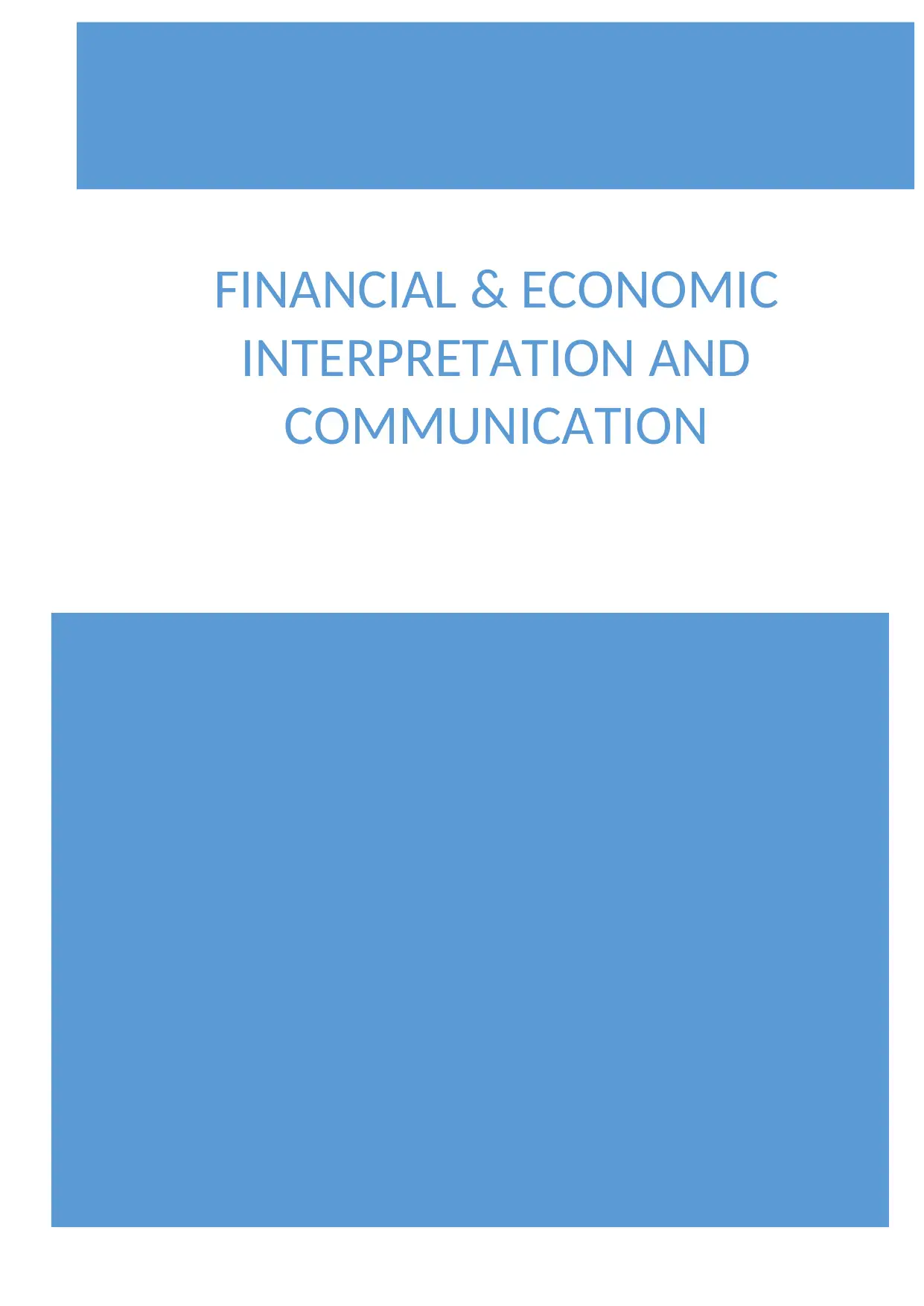
FINANCIAL & ECONOMIC
INTERPRETATION AND
COMMUNICATION
INTERPRETATION AND
COMMUNICATION
Paraphrase This Document
Need a fresh take? Get an instant paraphrase of this document with our AI Paraphraser
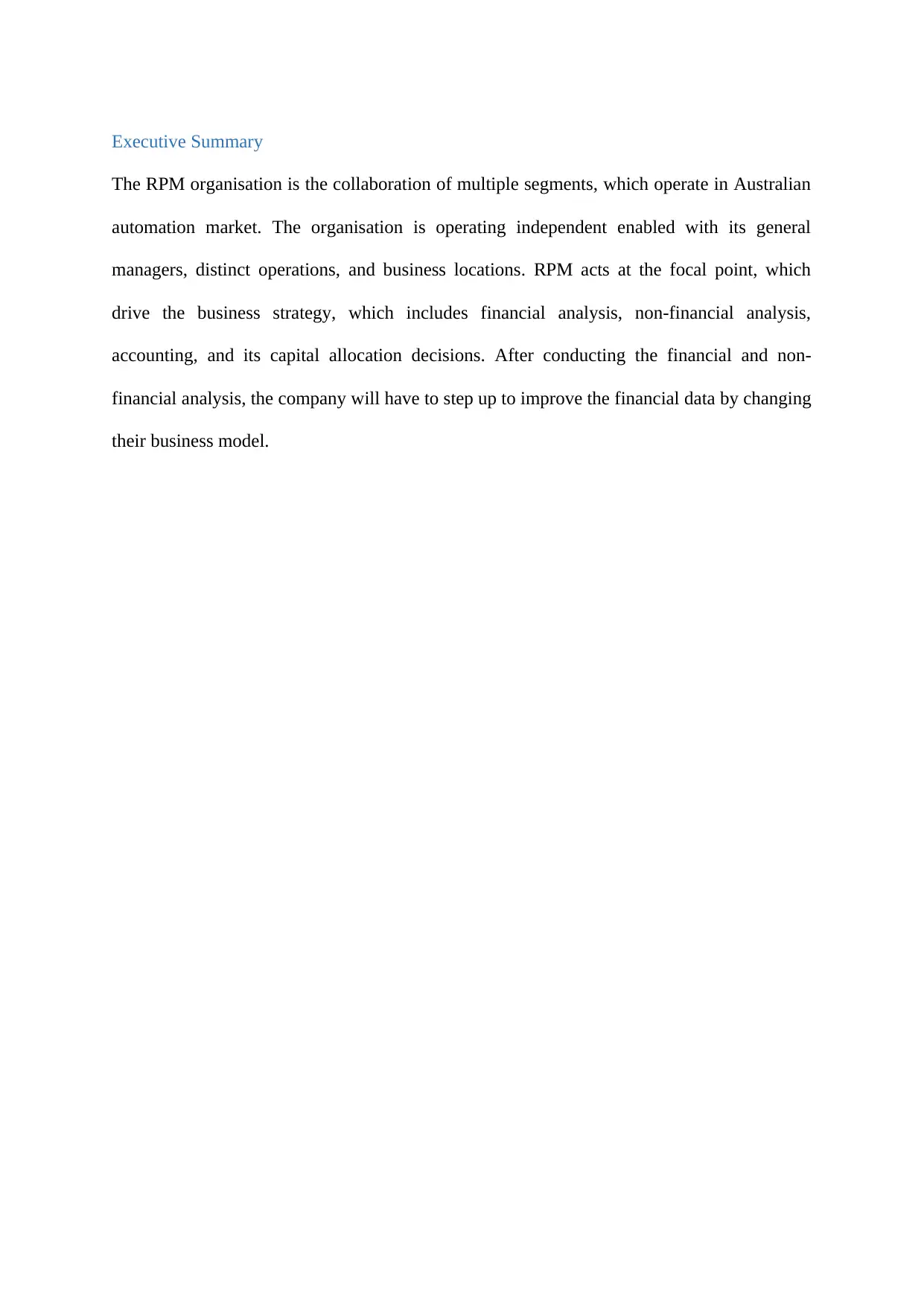
Executive Summary
The RPM organisation is the collaboration of multiple segments, which operate in Australian
automation market. The organisation is operating independent enabled with its general
managers, distinct operations, and business locations. RPM acts at the focal point, which
drive the business strategy, which includes financial analysis, non-financial analysis,
accounting, and its capital allocation decisions. After conducting the financial and non-
financial analysis, the company will have to step up to improve the financial data by changing
their business model.
The RPM organisation is the collaboration of multiple segments, which operate in Australian
automation market. The organisation is operating independent enabled with its general
managers, distinct operations, and business locations. RPM acts at the focal point, which
drive the business strategy, which includes financial analysis, non-financial analysis,
accounting, and its capital allocation decisions. After conducting the financial and non-
financial analysis, the company will have to step up to improve the financial data by changing
their business model.
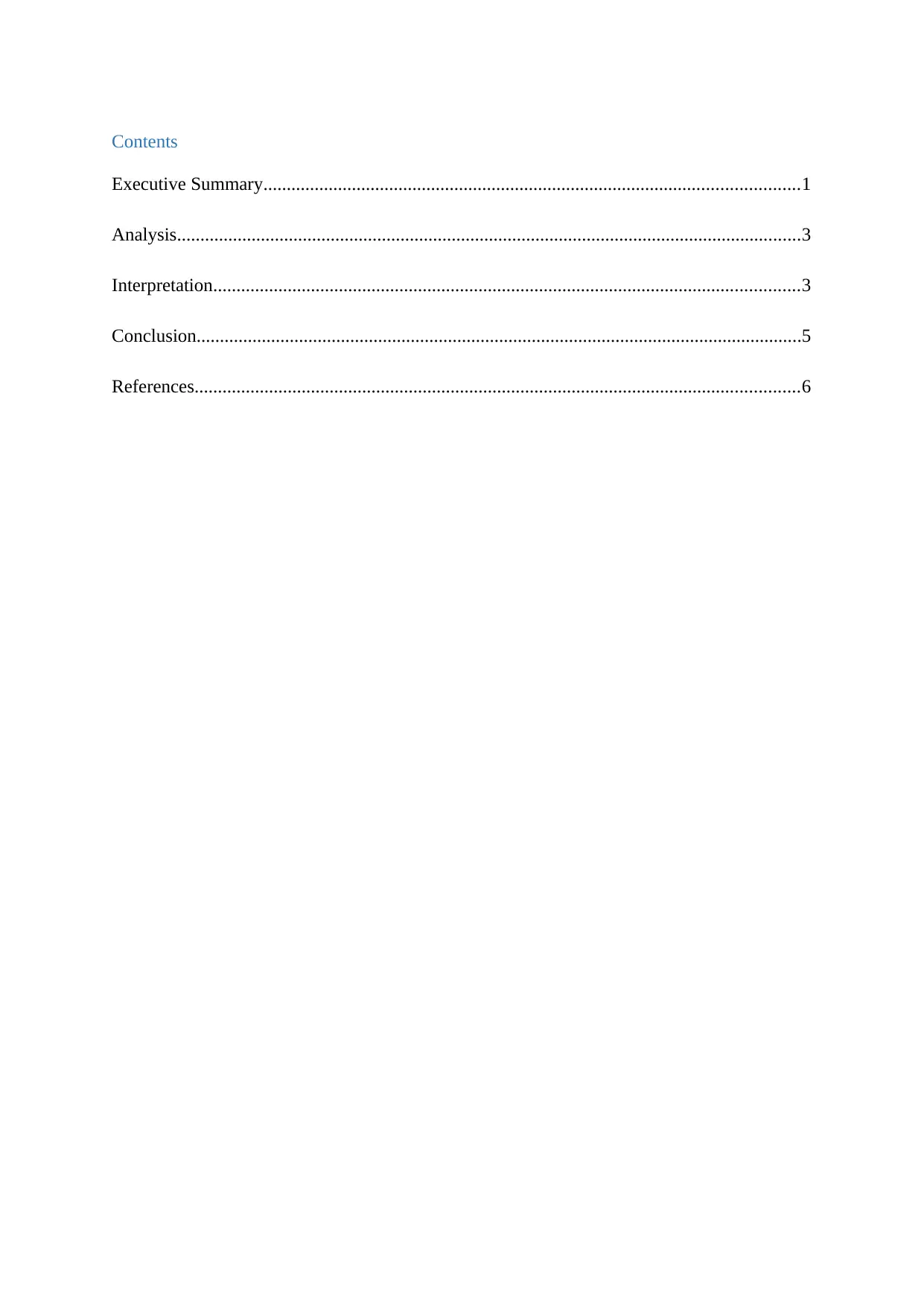
Contents
Executive Summary...................................................................................................................1
Analysis......................................................................................................................................3
Interpretation..............................................................................................................................3
Conclusion..................................................................................................................................5
References..................................................................................................................................6
Executive Summary...................................................................................................................1
Analysis......................................................................................................................................3
Interpretation..............................................................................................................................3
Conclusion..................................................................................................................................5
References..................................................................................................................................6
⊘ This is a preview!⊘
Do you want full access?
Subscribe today to unlock all pages.

Trusted by 1+ million students worldwide
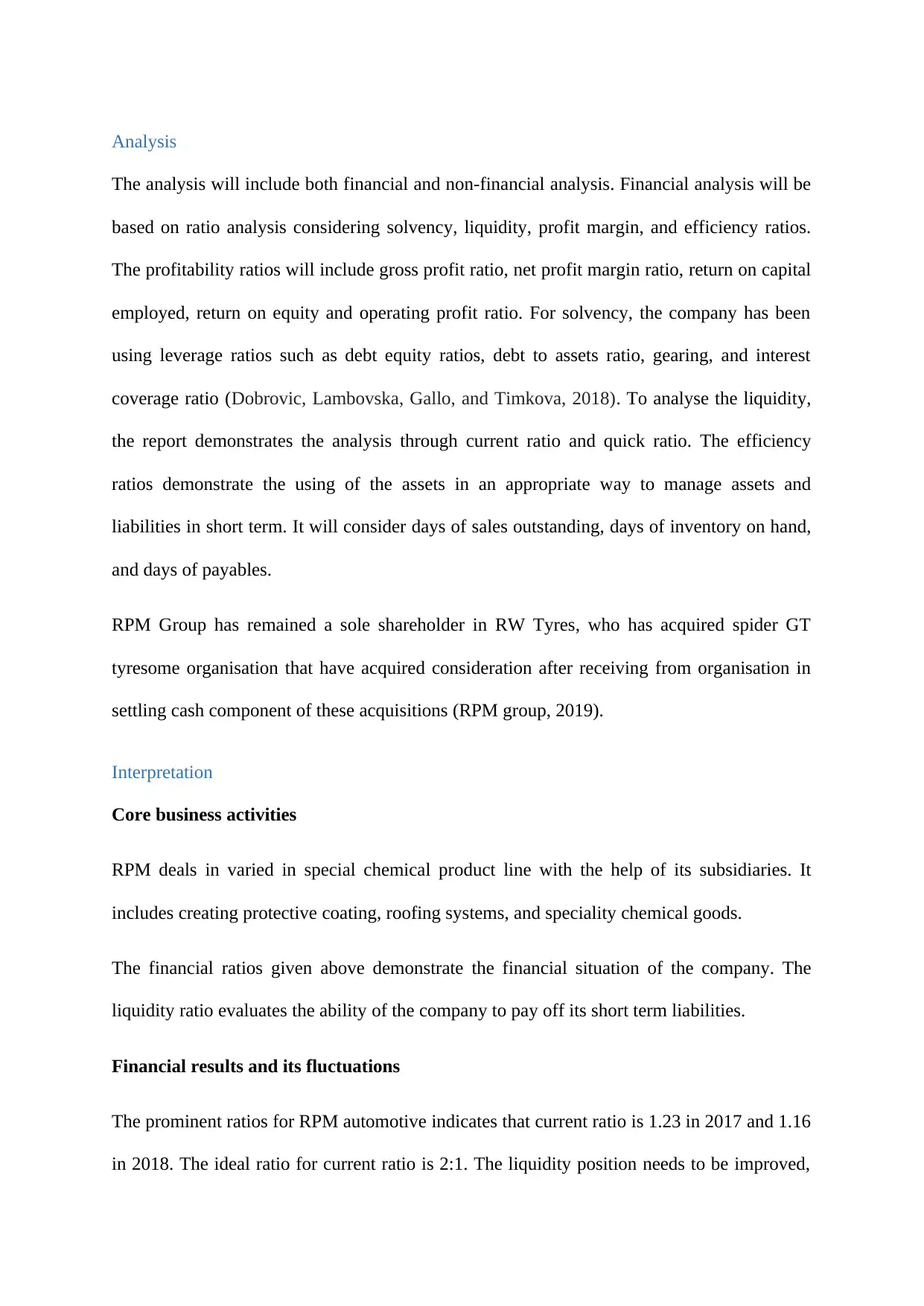
Analysis
The analysis will include both financial and non-financial analysis. Financial analysis will be
based on ratio analysis considering solvency, liquidity, profit margin, and efficiency ratios.
The profitability ratios will include gross profit ratio, net profit margin ratio, return on capital
employed, return on equity and operating profit ratio. For solvency, the company has been
using leverage ratios such as debt equity ratios, debt to assets ratio, gearing, and interest
coverage ratio (Dobrovic, Lambovska, Gallo, and Timkova, 2018). To analyse the liquidity,
the report demonstrates the analysis through current ratio and quick ratio. The efficiency
ratios demonstrate the using of the assets in an appropriate way to manage assets and
liabilities in short term. It will consider days of sales outstanding, days of inventory on hand,
and days of payables.
RPM Group has remained a sole shareholder in RW Tyres, who has acquired spider GT
tyresome organisation that have acquired consideration after receiving from organisation in
settling cash component of these acquisitions (RPM group, 2019).
Interpretation
Core business activities
RPM deals in varied in special chemical product line with the help of its subsidiaries. It
includes creating protective coating, roofing systems, and speciality chemical goods.
The financial ratios given above demonstrate the financial situation of the company. The
liquidity ratio evaluates the ability of the company to pay off its short term liabilities.
Financial results and its fluctuations
The prominent ratios for RPM automotive indicates that current ratio is 1.23 in 2017 and 1.16
in 2018. The ideal ratio for current ratio is 2:1. The liquidity position needs to be improved,
The analysis will include both financial and non-financial analysis. Financial analysis will be
based on ratio analysis considering solvency, liquidity, profit margin, and efficiency ratios.
The profitability ratios will include gross profit ratio, net profit margin ratio, return on capital
employed, return on equity and operating profit ratio. For solvency, the company has been
using leverage ratios such as debt equity ratios, debt to assets ratio, gearing, and interest
coverage ratio (Dobrovic, Lambovska, Gallo, and Timkova, 2018). To analyse the liquidity,
the report demonstrates the analysis through current ratio and quick ratio. The efficiency
ratios demonstrate the using of the assets in an appropriate way to manage assets and
liabilities in short term. It will consider days of sales outstanding, days of inventory on hand,
and days of payables.
RPM Group has remained a sole shareholder in RW Tyres, who has acquired spider GT
tyresome organisation that have acquired consideration after receiving from organisation in
settling cash component of these acquisitions (RPM group, 2019).
Interpretation
Core business activities
RPM deals in varied in special chemical product line with the help of its subsidiaries. It
includes creating protective coating, roofing systems, and speciality chemical goods.
The financial ratios given above demonstrate the financial situation of the company. The
liquidity ratio evaluates the ability of the company to pay off its short term liabilities.
Financial results and its fluctuations
The prominent ratios for RPM automotive indicates that current ratio is 1.23 in 2017 and 1.16
in 2018. The ideal ratio for current ratio is 2:1. The liquidity position needs to be improved,
Paraphrase This Document
Need a fresh take? Get an instant paraphrase of this document with our AI Paraphraser
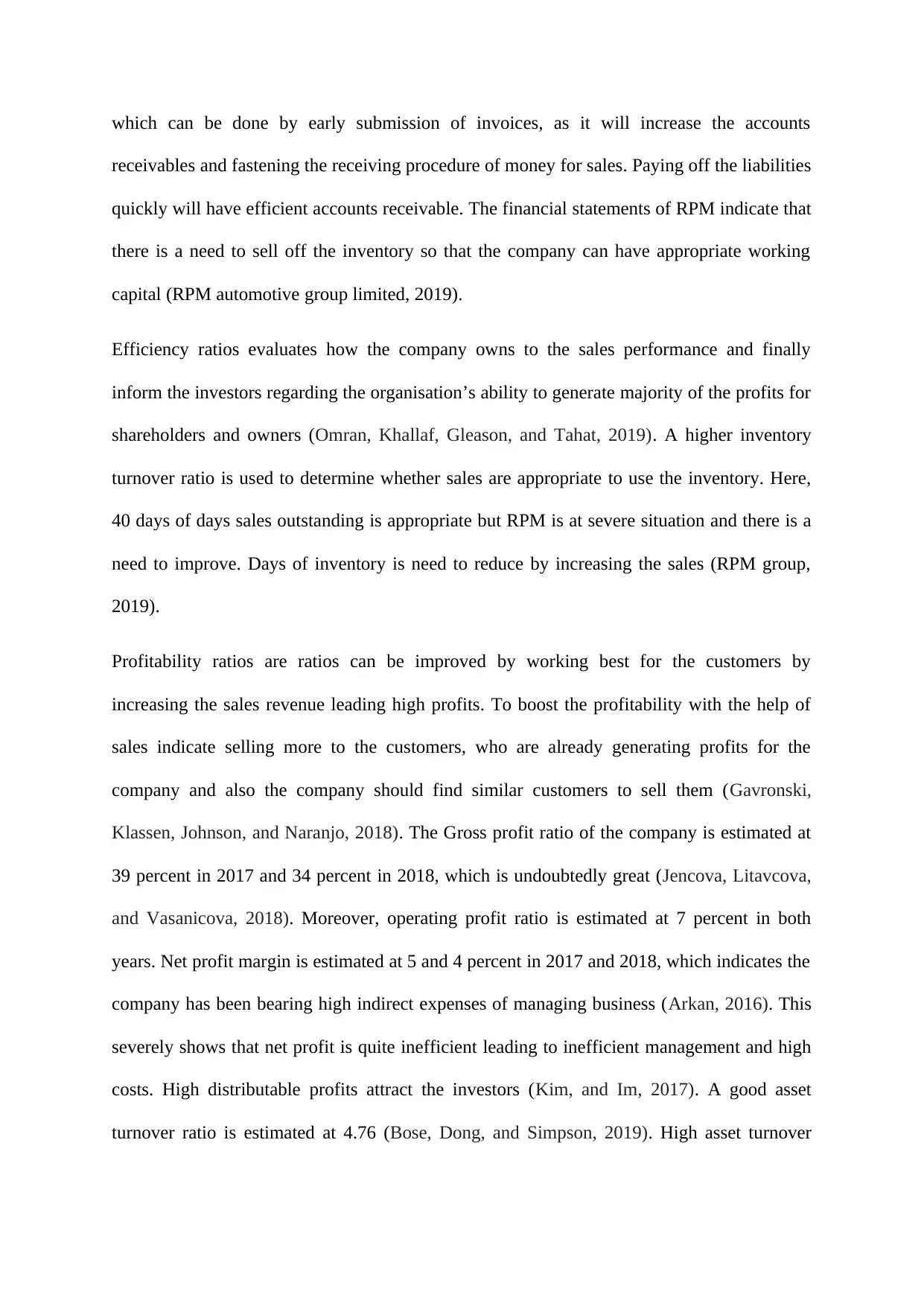
which can be done by early submission of invoices, as it will increase the accounts
receivables and fastening the receiving procedure of money for sales. Paying off the liabilities
quickly will have efficient accounts receivable. The financial statements of RPM indicate that
there is a need to sell off the inventory so that the company can have appropriate working
capital (RPM automotive group limited, 2019).
Efficiency ratios evaluates how the company owns to the sales performance and finally
inform the investors regarding the organisation’s ability to generate majority of the profits for
shareholders and owners (Omran, Khallaf, Gleason, and Tahat, 2019). A higher inventory
turnover ratio is used to determine whether sales are appropriate to use the inventory. Here,
40 days of days sales outstanding is appropriate but RPM is at severe situation and there is a
need to improve. Days of inventory is need to reduce by increasing the sales (RPM group,
2019).
Profitability ratios are ratios can be improved by working best for the customers by
increasing the sales revenue leading high profits. To boost the profitability with the help of
sales indicate selling more to the customers, who are already generating profits for the
company and also the company should find similar customers to sell them (Gavronski,
Klassen, Johnson, and Naranjo, 2018). The Gross profit ratio of the company is estimated at
39 percent in 2017 and 34 percent in 2018, which is undoubtedly great (Jencova, Litavcova,
and Vasanicova, 2018). Moreover, operating profit ratio is estimated at 7 percent in both
years. Net profit margin is estimated at 5 and 4 percent in 2017 and 2018, which indicates the
company has been bearing high indirect expenses of managing business (Arkan, 2016). This
severely shows that net profit is quite inefficient leading to inefficient management and high
costs. High distributable profits attract the investors (Kim, and Im, 2017). A good asset
turnover ratio is estimated at 4.76 (Bose, Dong, and Simpson, 2019). High asset turnover
receivables and fastening the receiving procedure of money for sales. Paying off the liabilities
quickly will have efficient accounts receivable. The financial statements of RPM indicate that
there is a need to sell off the inventory so that the company can have appropriate working
capital (RPM automotive group limited, 2019).
Efficiency ratios evaluates how the company owns to the sales performance and finally
inform the investors regarding the organisation’s ability to generate majority of the profits for
shareholders and owners (Omran, Khallaf, Gleason, and Tahat, 2019). A higher inventory
turnover ratio is used to determine whether sales are appropriate to use the inventory. Here,
40 days of days sales outstanding is appropriate but RPM is at severe situation and there is a
need to improve. Days of inventory is need to reduce by increasing the sales (RPM group,
2019).
Profitability ratios are ratios can be improved by working best for the customers by
increasing the sales revenue leading high profits. To boost the profitability with the help of
sales indicate selling more to the customers, who are already generating profits for the
company and also the company should find similar customers to sell them (Gavronski,
Klassen, Johnson, and Naranjo, 2018). The Gross profit ratio of the company is estimated at
39 percent in 2017 and 34 percent in 2018, which is undoubtedly great (Jencova, Litavcova,
and Vasanicova, 2018). Moreover, operating profit ratio is estimated at 7 percent in both
years. Net profit margin is estimated at 5 and 4 percent in 2017 and 2018, which indicates the
company has been bearing high indirect expenses of managing business (Arkan, 2016). This
severely shows that net profit is quite inefficient leading to inefficient management and high
costs. High distributable profits attract the investors (Kim, and Im, 2017). A good asset
turnover ratio is estimated at 4.76 (Bose, Dong, and Simpson, 2019). High asset turnover
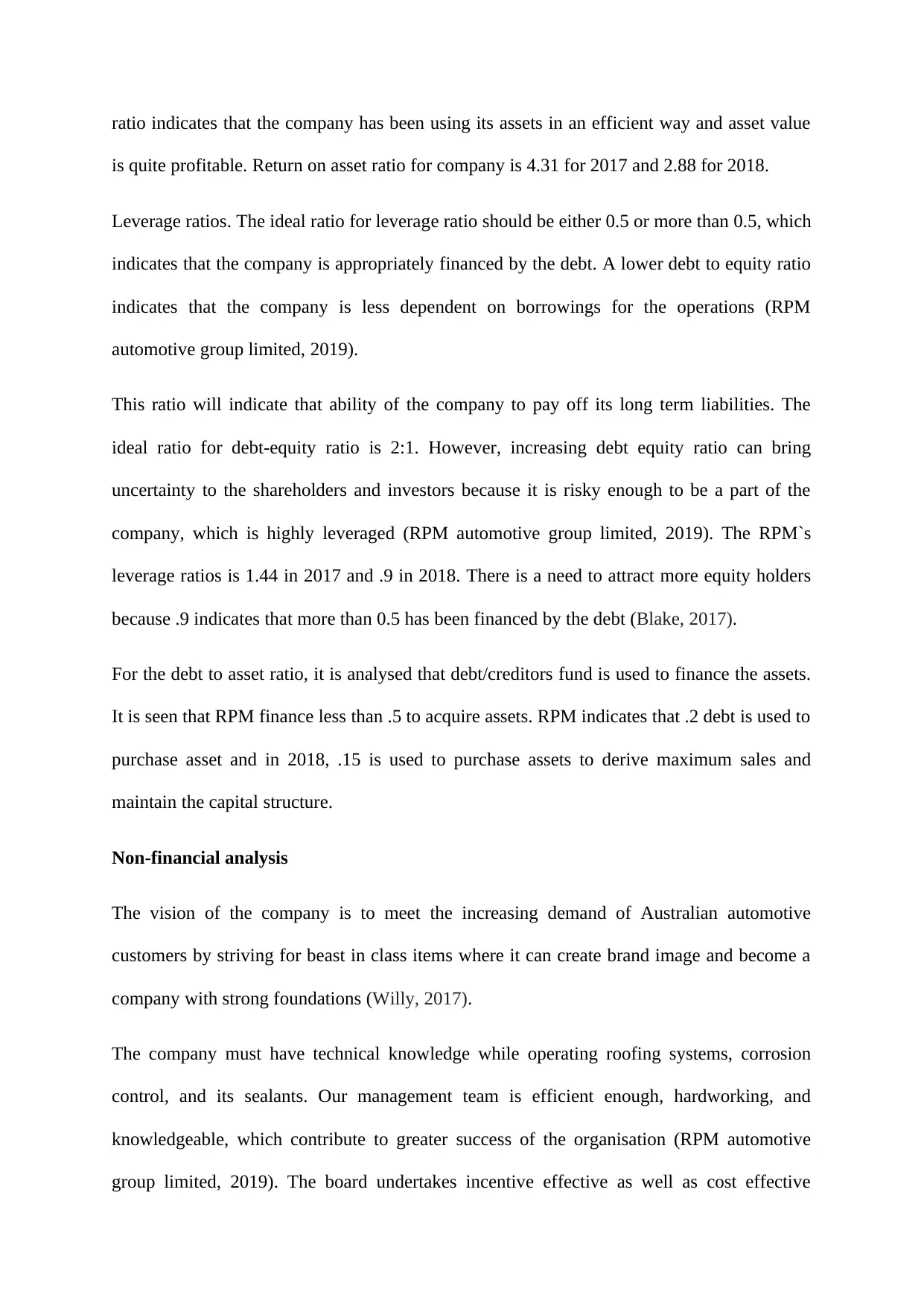
ratio indicates that the company has been using its assets in an efficient way and asset value
is quite profitable. Return on asset ratio for company is 4.31 for 2017 and 2.88 for 2018.
Leverage ratios. The ideal ratio for leverage ratio should be either 0.5 or more than 0.5, which
indicates that the company is appropriately financed by the debt. A lower debt to equity ratio
indicates that the company is less dependent on borrowings for the operations (RPM
automotive group limited, 2019).
This ratio will indicate that ability of the company to pay off its long term liabilities. The
ideal ratio for debt-equity ratio is 2:1. However, increasing debt equity ratio can bring
uncertainty to the shareholders and investors because it is risky enough to be a part of the
company, which is highly leveraged (RPM automotive group limited, 2019). The RPM`s
leverage ratios is 1.44 in 2017 and .9 in 2018. There is a need to attract more equity holders
because .9 indicates that more than 0.5 has been financed by the debt (Blake, 2017).
For the debt to asset ratio, it is analysed that debt/creditors fund is used to finance the assets.
It is seen that RPM finance less than .5 to acquire assets. RPM indicates that .2 debt is used to
purchase asset and in 2018, .15 is used to purchase assets to derive maximum sales and
maintain the capital structure.
Non-financial analysis
The vision of the company is to meet the increasing demand of Australian automotive
customers by striving for beast in class items where it can create brand image and become a
company with strong foundations (Willy, 2017).
The company must have technical knowledge while operating roofing systems, corrosion
control, and its sealants. Our management team is efficient enough, hardworking, and
knowledgeable, which contribute to greater success of the organisation (RPM automotive
group limited, 2019). The board undertakes incentive effective as well as cost effective
is quite profitable. Return on asset ratio for company is 4.31 for 2017 and 2.88 for 2018.
Leverage ratios. The ideal ratio for leverage ratio should be either 0.5 or more than 0.5, which
indicates that the company is appropriately financed by the debt. A lower debt to equity ratio
indicates that the company is less dependent on borrowings for the operations (RPM
automotive group limited, 2019).
This ratio will indicate that ability of the company to pay off its long term liabilities. The
ideal ratio for debt-equity ratio is 2:1. However, increasing debt equity ratio can bring
uncertainty to the shareholders and investors because it is risky enough to be a part of the
company, which is highly leveraged (RPM automotive group limited, 2019). The RPM`s
leverage ratios is 1.44 in 2017 and .9 in 2018. There is a need to attract more equity holders
because .9 indicates that more than 0.5 has been financed by the debt (Blake, 2017).
For the debt to asset ratio, it is analysed that debt/creditors fund is used to finance the assets.
It is seen that RPM finance less than .5 to acquire assets. RPM indicates that .2 debt is used to
purchase asset and in 2018, .15 is used to purchase assets to derive maximum sales and
maintain the capital structure.
Non-financial analysis
The vision of the company is to meet the increasing demand of Australian automotive
customers by striving for beast in class items where it can create brand image and become a
company with strong foundations (Willy, 2017).
The company must have technical knowledge while operating roofing systems, corrosion
control, and its sealants. Our management team is efficient enough, hardworking, and
knowledgeable, which contribute to greater success of the organisation (RPM automotive
group limited, 2019). The board undertakes incentive effective as well as cost effective
⊘ This is a preview!⊘
Do you want full access?
Subscribe today to unlock all pages.

Trusted by 1+ million students worldwide
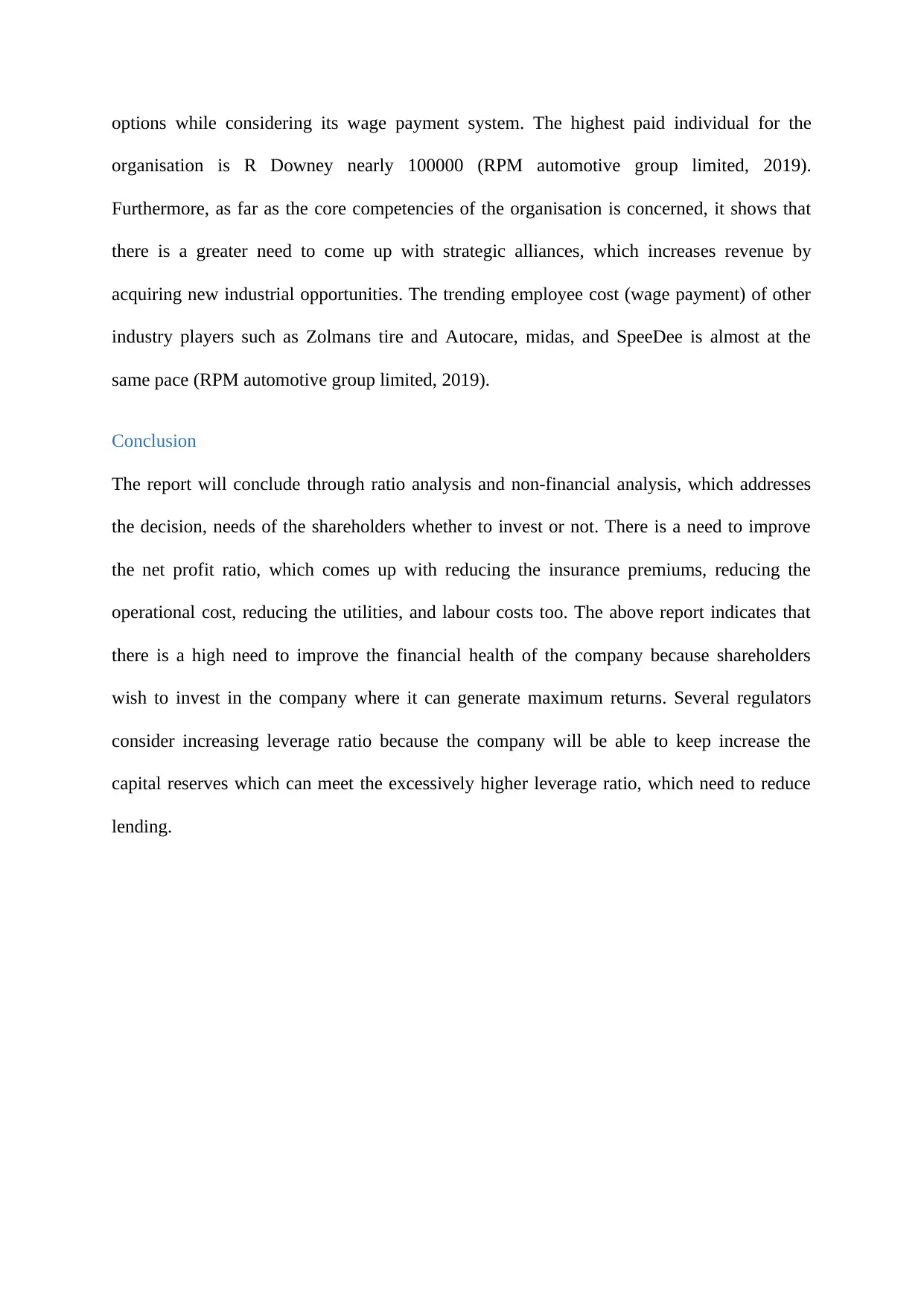
options while considering its wage payment system. The highest paid individual for the
organisation is R Downey nearly 100000 (RPM automotive group limited, 2019).
Furthermore, as far as the core competencies of the organisation is concerned, it shows that
there is a greater need to come up with strategic alliances, which increases revenue by
acquiring new industrial opportunities. The trending employee cost (wage payment) of other
industry players such as Zolmans tire and Autocare, midas, and SpeeDee is almost at the
same pace (RPM automotive group limited, 2019).
Conclusion
The report will conclude through ratio analysis and non-financial analysis, which addresses
the decision, needs of the shareholders whether to invest or not. There is a need to improve
the net profit ratio, which comes up with reducing the insurance premiums, reducing the
operational cost, reducing the utilities, and labour costs too. The above report indicates that
there is a high need to improve the financial health of the company because shareholders
wish to invest in the company where it can generate maximum returns. Several regulators
consider increasing leverage ratio because the company will be able to keep increase the
capital reserves which can meet the excessively higher leverage ratio, which need to reduce
lending.
organisation is R Downey nearly 100000 (RPM automotive group limited, 2019).
Furthermore, as far as the core competencies of the organisation is concerned, it shows that
there is a greater need to come up with strategic alliances, which increases revenue by
acquiring new industrial opportunities. The trending employee cost (wage payment) of other
industry players such as Zolmans tire and Autocare, midas, and SpeeDee is almost at the
same pace (RPM automotive group limited, 2019).
Conclusion
The report will conclude through ratio analysis and non-financial analysis, which addresses
the decision, needs of the shareholders whether to invest or not. There is a need to improve
the net profit ratio, which comes up with reducing the insurance premiums, reducing the
operational cost, reducing the utilities, and labour costs too. The above report indicates that
there is a high need to improve the financial health of the company because shareholders
wish to invest in the company where it can generate maximum returns. Several regulators
consider increasing leverage ratio because the company will be able to keep increase the
capital reserves which can meet the excessively higher leverage ratio, which need to reduce
lending.
Paraphrase This Document
Need a fresh take? Get an instant paraphrase of this document with our AI Paraphraser
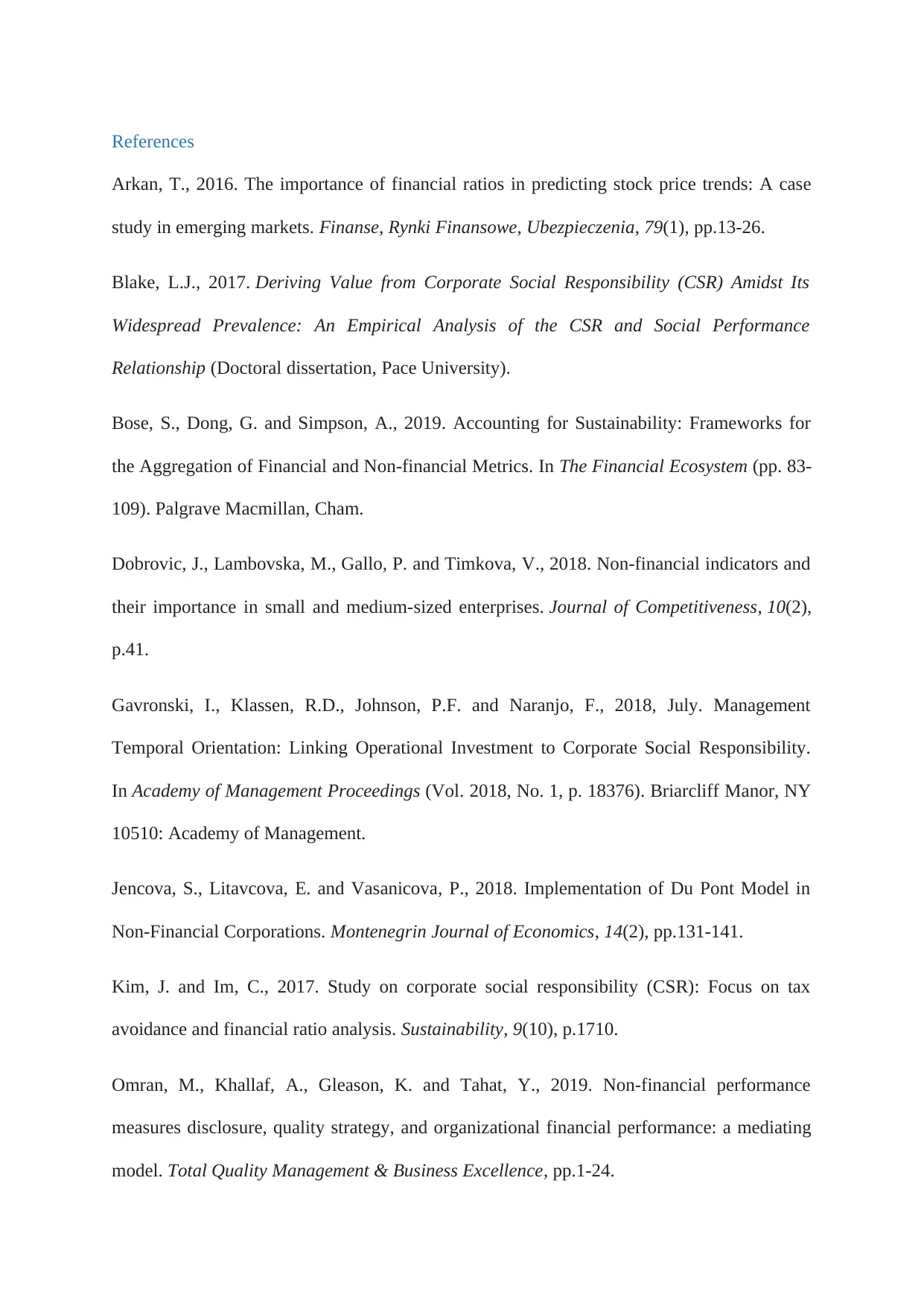
References
Arkan, T., 2016. The importance of financial ratios in predicting stock price trends: A case
study in emerging markets. Finanse, Rynki Finansowe, Ubezpieczenia, 79(1), pp.13-26.
Blake, L.J., 2017. Deriving Value from Corporate Social Responsibility (CSR) Amidst Its
Widespread Prevalence: An Empirical Analysis of the CSR and Social Performance
Relationship (Doctoral dissertation, Pace University).
Bose, S., Dong, G. and Simpson, A., 2019. Accounting for Sustainability: Frameworks for
the Aggregation of Financial and Non-financial Metrics. In The Financial Ecosystem (pp. 83-
109). Palgrave Macmillan, Cham.
Dobrovic, J., Lambovska, M., Gallo, P. and Timkova, V., 2018. Non-financial indicators and
their importance in small and medium-sized enterprises. Journal of Competitiveness, 10(2),
p.41.
Gavronski, I., Klassen, R.D., Johnson, P.F. and Naranjo, F., 2018, July. Management
Temporal Orientation: Linking Operational Investment to Corporate Social Responsibility.
In Academy of Management Proceedings (Vol. 2018, No. 1, p. 18376). Briarcliff Manor, NY
10510: Academy of Management.
Jencova, S., Litavcova, E. and Vasanicova, P., 2018. Implementation of Du Pont Model in
Non-Financial Corporations. Montenegrin Journal of Economics, 14(2), pp.131-141.
Kim, J. and Im, C., 2017. Study on corporate social responsibility (CSR): Focus on tax
avoidance and financial ratio analysis. Sustainability, 9(10), p.1710.
Omran, M., Khallaf, A., Gleason, K. and Tahat, Y., 2019. Non-financial performance
measures disclosure, quality strategy, and organizational financial performance: a mediating
model. Total Quality Management & Business Excellence, pp.1-24.
Arkan, T., 2016. The importance of financial ratios in predicting stock price trends: A case
study in emerging markets. Finanse, Rynki Finansowe, Ubezpieczenia, 79(1), pp.13-26.
Blake, L.J., 2017. Deriving Value from Corporate Social Responsibility (CSR) Amidst Its
Widespread Prevalence: An Empirical Analysis of the CSR and Social Performance
Relationship (Doctoral dissertation, Pace University).
Bose, S., Dong, G. and Simpson, A., 2019. Accounting for Sustainability: Frameworks for
the Aggregation of Financial and Non-financial Metrics. In The Financial Ecosystem (pp. 83-
109). Palgrave Macmillan, Cham.
Dobrovic, J., Lambovska, M., Gallo, P. and Timkova, V., 2018. Non-financial indicators and
their importance in small and medium-sized enterprises. Journal of Competitiveness, 10(2),
p.41.
Gavronski, I., Klassen, R.D., Johnson, P.F. and Naranjo, F., 2018, July. Management
Temporal Orientation: Linking Operational Investment to Corporate Social Responsibility.
In Academy of Management Proceedings (Vol. 2018, No. 1, p. 18376). Briarcliff Manor, NY
10510: Academy of Management.
Jencova, S., Litavcova, E. and Vasanicova, P., 2018. Implementation of Du Pont Model in
Non-Financial Corporations. Montenegrin Journal of Economics, 14(2), pp.131-141.
Kim, J. and Im, C., 2017. Study on corporate social responsibility (CSR): Focus on tax
avoidance and financial ratio analysis. Sustainability, 9(10), p.1710.
Omran, M., Khallaf, A., Gleason, K. and Tahat, Y., 2019. Non-financial performance
measures disclosure, quality strategy, and organizational financial performance: a mediating
model. Total Quality Management & Business Excellence, pp.1-24.
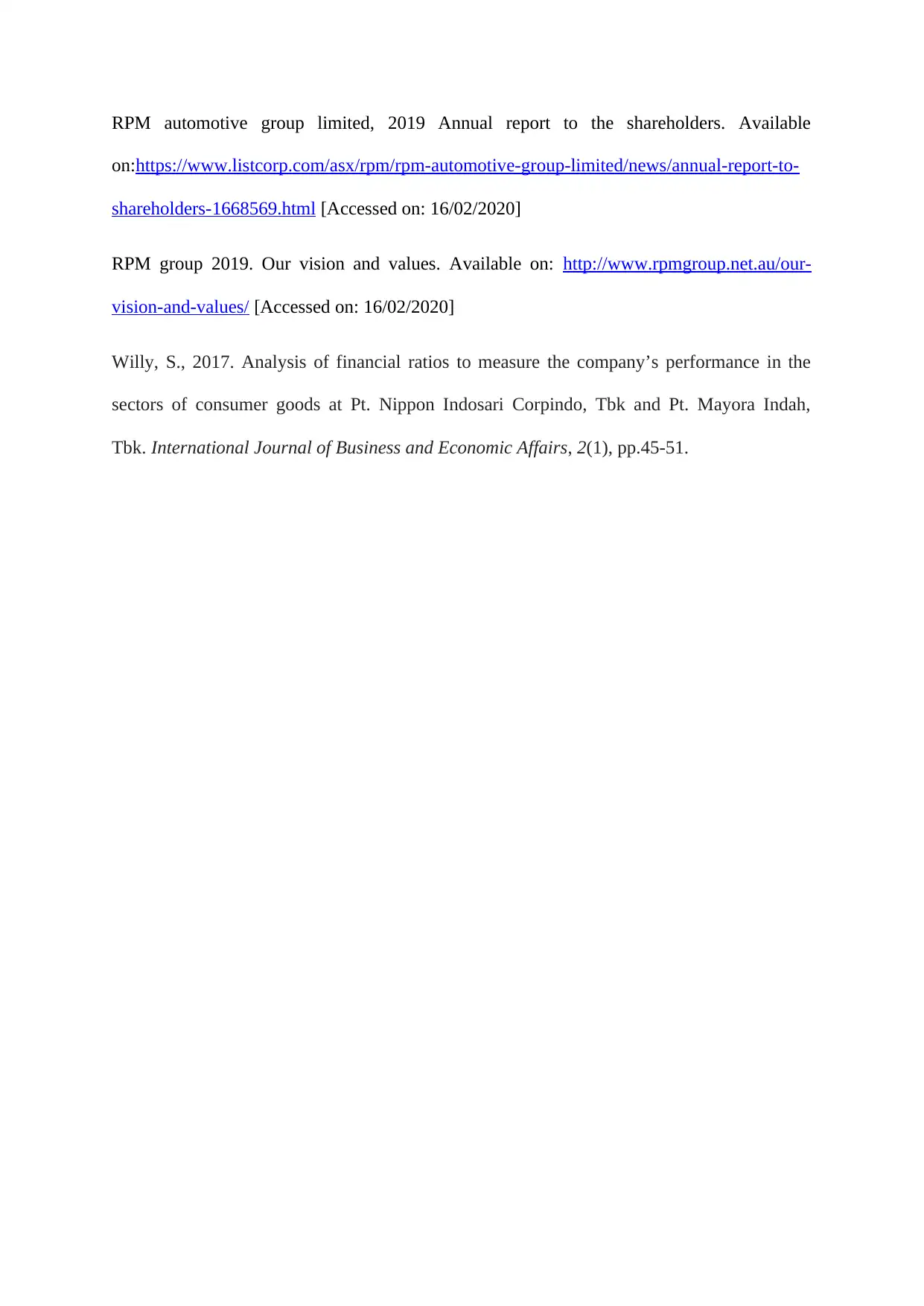
RPM automotive group limited, 2019 Annual report to the shareholders. Available
on:https://www.listcorp.com/asx/rpm/rpm-automotive-group-limited/news/annual-report-to-
shareholders-1668569.html [Accessed on: 16/02/2020]
RPM group 2019. Our vision and values. Available on: http://www.rpmgroup.net.au/our-
vision-and-values/ [Accessed on: 16/02/2020]
Willy, S., 2017. Analysis of financial ratios to measure the company’s performance in the
sectors of consumer goods at Pt. Nippon Indosari Corpindo, Tbk and Pt. Mayora Indah,
Tbk. International Journal of Business and Economic Affairs, 2(1), pp.45-51.
on:https://www.listcorp.com/asx/rpm/rpm-automotive-group-limited/news/annual-report-to-
shareholders-1668569.html [Accessed on: 16/02/2020]
RPM group 2019. Our vision and values. Available on: http://www.rpmgroup.net.au/our-
vision-and-values/ [Accessed on: 16/02/2020]
Willy, S., 2017. Analysis of financial ratios to measure the company’s performance in the
sectors of consumer goods at Pt. Nippon Indosari Corpindo, Tbk and Pt. Mayora Indah,
Tbk. International Journal of Business and Economic Affairs, 2(1), pp.45-51.
⊘ This is a preview!⊘
Do you want full access?
Subscribe today to unlock all pages.

Trusted by 1+ million students worldwide
1 out of 9
Related Documents
Your All-in-One AI-Powered Toolkit for Academic Success.
+13062052269
info@desklib.com
Available 24*7 on WhatsApp / Email
![[object Object]](/_next/static/media/star-bottom.7253800d.svg)
Unlock your academic potential
Copyright © 2020–2025 A2Z Services. All Rights Reserved. Developed and managed by ZUCOL.





